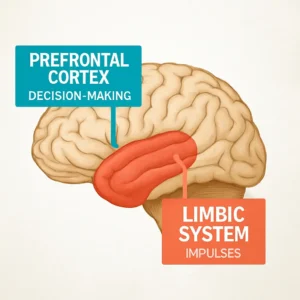Why Do Teens Commit Crimes? A Scientific Look at Causes and Psychology
Teen crime—often called juvenile delinquency—is one of the most concerning social issues worldwide. Whether it’s theft, violence, substance abuse, or cybercrime, adolescent involvement in unlawful acts impacts not just their own future but also families and communities.
Why do some teens turn to crime while others, raised in similar environments, don’t? Research shows that it’s rarely one single factor—it’s an interaction of biology, psychology, family, peer influence, and society.
This blog explores the scientifically proven causes of juvenile delinquency, its psychological roots, and holistic approaches to prevention.
1. Brain Development and Risk-Taking

The adolescent brain is still under construction.
-
The prefrontal cortex (responsible for decision-making, impulse control, and foresight) matures last—well into the mid-20s.
-
Meanwhile, the limbic system (emotions, rewards, thrill-seeking) is highly active during adolescence.
This imbalance makes teens more likely to:
-
Act impulsively
-
Take risks for excitement
-
Struggle with long-term consequences
According to the U.S. National Institute of Justice, this brain development pattern is a major contributor to juvenile delinquency.
2. Family Environment
A large body of research links family dynamics to teen crime:
-
Parental neglect or lack of supervision → higher risk of delinquency
-
Domestic violence or abuse → normalizes aggression
-
Broken families, divorce, or absence of one parent → increases vulnerability
-
Overly harsh or inconsistent discipline → fosters rebellion
Strong parental bonding and open communication, on the other hand, are protective factors.
3. Peer Influence
Adolescents are deeply influenced by their peer groups. Peer pressure can lead to:
-
Shoplifting, drug use, or vandalism as a way to “fit in”
-
Gang involvement, where crime offers identity, belonging, or protection
Studies confirm that association with delinquent peers is one of the strongest predictors of teen crime.
4. Poverty and Social Inequality
Social environment shapes opportunity.
-
Teens in poverty-stricken neighborhoods face limited access to education, healthcare, and safe recreation.
-
Exposure to crime in the community makes illegal behavior appear “normal.”
-
Economic stress pushes some toward theft or drug trade as survival strategies.
Research highlights poverty and unemployment as core social drivers of delinquency.
5. School Factors

Schools are not just for academics—they are social training grounds.
-
Low school attachment (feeling disconnected from teachers and learning) increases crime risk.
-
Bullying (as victim or perpetrator) correlates with later delinquency.
-
School failure or dropout leads to frustration, pushing teens toward antisocial groups.
6. Substance Abuse
Substance abuse and crime often feed each other:
-
Alcohol/drugs lower inhibitions, fueling violence and risky behavior
-
Drug dependence can drive theft or drug dealing to fund addiction
-
Early exposure to substances increases risk of long-term criminal patterns
7. Psychological and Emotional Factors
Teen crime often masks deeper psychological struggles:
-
Low self-esteem → seeking validation through crime or gangs
-
Depression, trauma, or PTSD → aggression as coping mechanism
-
Personality disorders (rare but impactful) like conduct disorder
Brain studies show that chronic stress reshapes neural pathways, reinforcing impulsive behavior.
8. Media and Technology Influence
Today’s teens live online, where exposure to violence, pornography, or cybercrime opportunities is constant.
-
Violent video games or social media glorifying crime can normalize aggression
-
Cyberbullying and hacking introduce new forms of delinquency
-
The anonymity of the internet lowers fear of consequences
9. Protective Factors That Prevent Teen Crime
While risks are many, protective factors can dramatically reduce delinquency:
-
Stable family bonds
-
Mentorship from teachers or community leaders
-
After-school activities (sports, arts, volunteering)
-
Strong moral and spiritual guidance
-
Skill-building opportunities (job training, internships)
Research shows that even one caring adult can reduce a teen’s likelihood of committing crime.
10. Holistic Solutions to Juvenile Delinquency

a) Early Intervention
-
Identifying at-risk children (behavioral issues, truancy) before crime escalates
b) Family Support Programs
-
Parenting workshops on communication and discipline
-
Therapy for families dealing with violence or addiction
c) School Initiatives
-
Anti-bullying campaigns
-
Emotional intelligence and life skills education
-
Career counseling to reduce dropout rates
d) Community Engagement
-
Safe spaces like libraries, sports clubs, youth centers
-
Community policing that builds trust, not fear
e) Restorative Justice
Instead of punishment alone, restorative justice focuses on:
-
Accountability
-
Repairing harm done
-
Reintegrating teens into society
The Bigger Picture: Society’s Responsibility
Teen crime is not just about “bad kids.” It reflects:
-
Family struggles
-
Community neglect
-
Systemic inequality
By investing in education, mental health, and opportunities, societies can reshape the paths of thousands of adolescents.
Conclusion
Teens commit crimes not because they are inherently “bad,” but because of a mix of brain immaturity, environmental pressures, psychological wounds, and social inequalities.
Understanding these roots helps us move from blame to solutions. Every supportive teacher, parent, counselor, or policymaker becomes part of the prevention.
✨ The future of youth is not written by their mistakes—it is rewritten by the opportunities we give them.

Leave a Reply